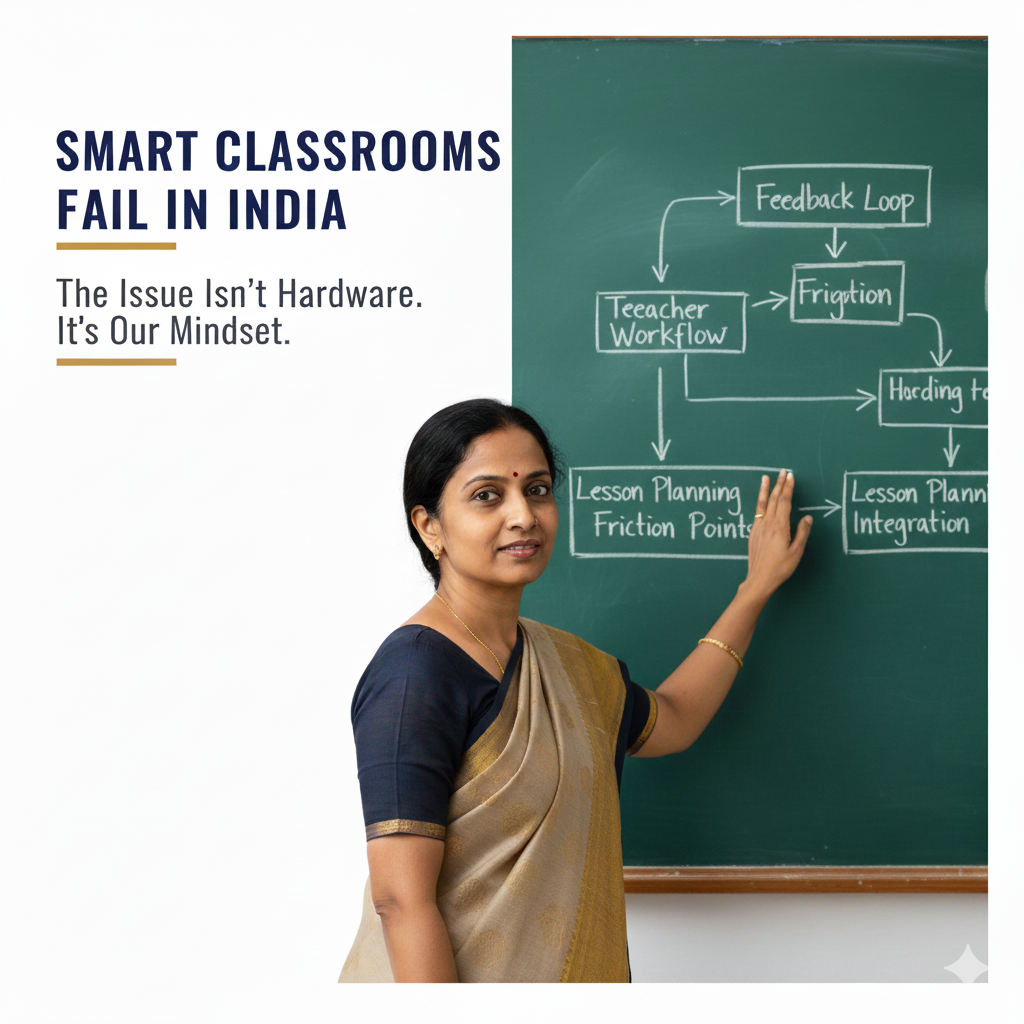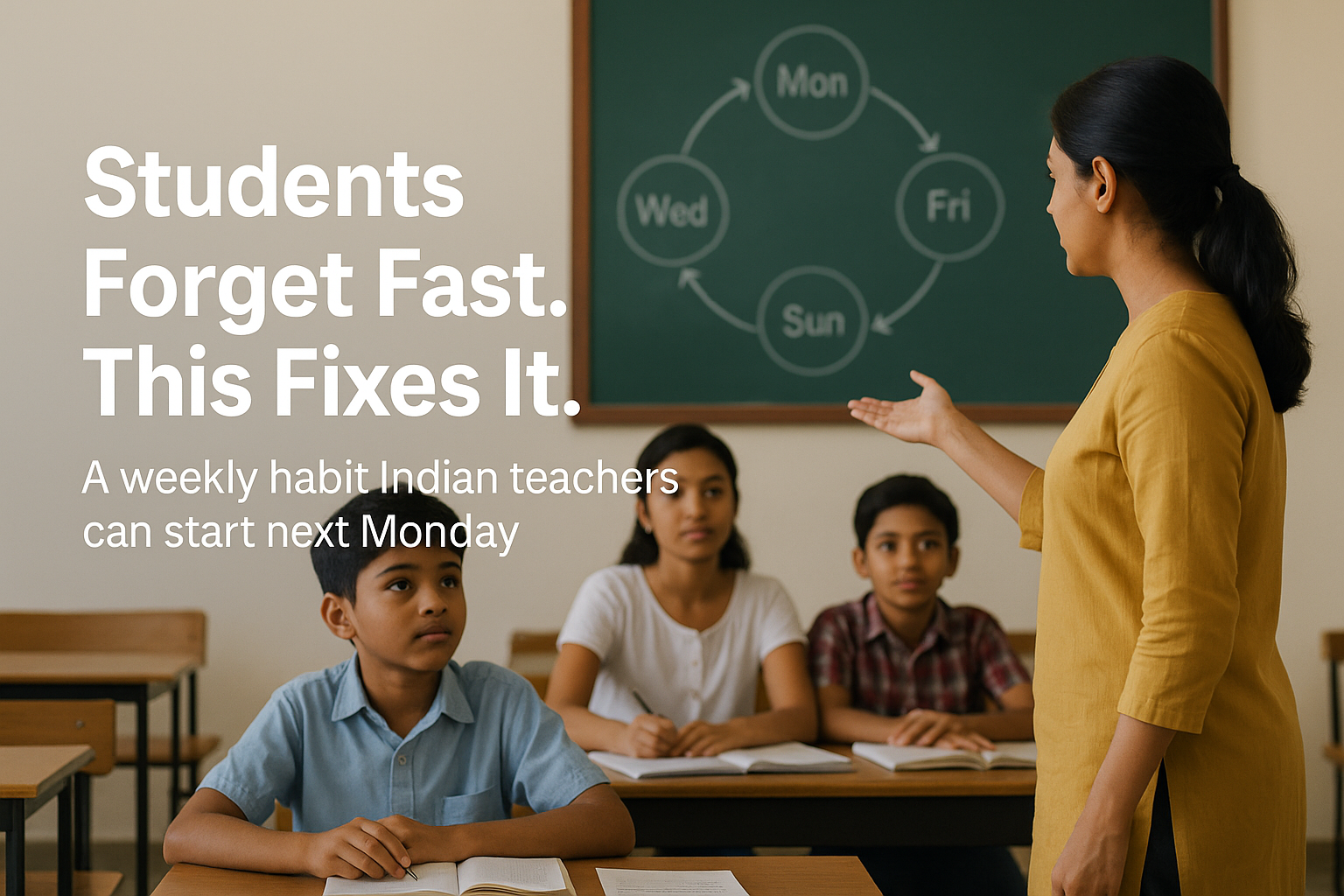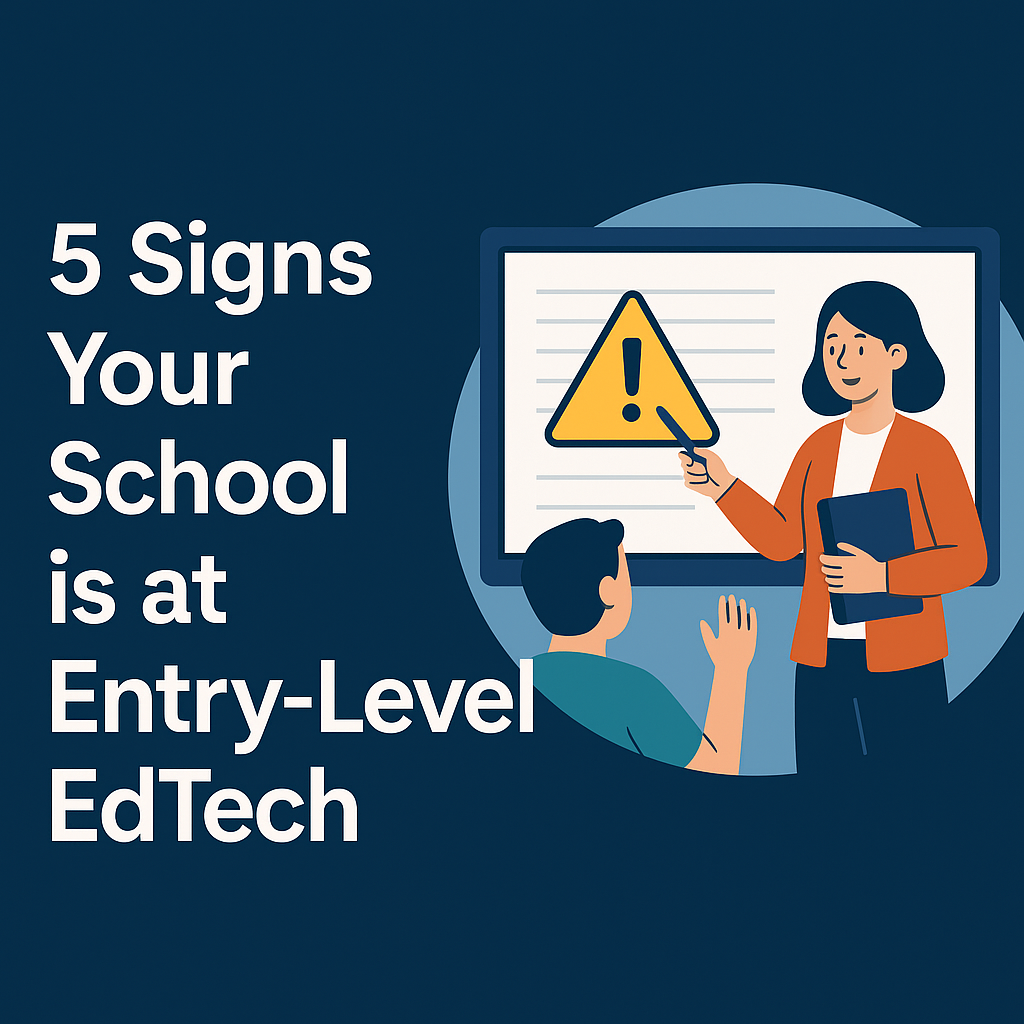Whats Hurting Our Classrooms
What’s Hurting Our Classrooms?
72% of classroom tech time in India is passive.
Students watch, teachers click, budgets drain.
And here’s the kicker: 30% of teachers are considering quitting because of tech stress.
Add to that 2+ hours wasted weekly on troubleshooting logins and glitches, and you see the hidden drain on our classrooms.
The problem isn’t the SMART Board or the laptop.
The problem lies in how we use (or don’t use) them.
The Reality We Can’t Ignore
Walk into most schools today and you’ll see crores invested in technology—interactive panels, projectors, tablets. But too often, the scene looks the same:
- Teacher opens a PowerPoint.
- Students copy notes quietly.
- The “interactive” board glows like an expensive white screen.
Sound familiar?
It’s not laziness. It’s the system we’ve built. Budget constraints force schools to “show” parents shiny tech, but there’s little time or training to build real teaching habits.
Add exam pressure, 40+ students per class, and limited teacher bandwidth, and the tech-to-learning gap only widens.
1. Tech Without Habits
Buying a panel is easy.
Building teacher routines around it? That’s the hard part.
In one Chennai school I worked with, teachers had state-of-the-art panels installed. But after 6 months, usage was down to less than 10% of lesson time.
Why?
Because nobody showed teachers how to start a class in under 2 minutes, or how to use the board to pull student thinking onto the screen.
Meanwhile, across India, schools lose hundreds of instructional hours annually because teachers double as unpaid IT support
Actionable fix:
- Train teachers on micro-habits, not just tools. For example: “Every class starts with a two-minute poll” or “End every lesson with a student-created mind map.”
- Track Weekly Active Panel Use as a metric, not just “Did the panel turn on?”
2. The Exam Culture Overhang
Indian classrooms are built like factories, output measured by board results. Technology is judged by how well it supports revision, not exploration.
I’ve seen schools where teachers use digital boards only for past-year question papers.
It’s efficient, sure. But it kills curiosity.
Actionable fix:
- Allocate one period a week as an exploration block—students use tech to create, not consume.
- Celebrate not just “marks improved” but also “students presented ideas digitally” or “peer-led quiz using EdTech tools.”
3. Staff Training That Stops at Installation
Too many schools treat teacher PD (professional development) as a one-time orientation.
The “demo day” ends, the trainer leaves, and teachers are expected to swim on their own.
The result?
Expensive tools become glorified display boards. No wonder teacher turnover is rising, with burnout fueled by tech overload
Actionable fix:
- Move from “one-time training” to habit loops.
- Example: a 6-week sprint where teachers practice one feature each week—polls, annotations, breakout tasks—and get feedback.
- Build peer champions inside the school. A teacher who’s mastered Lumio or Google Classroom can mentor 5 others.
4. Budgets Spent Wrong
Schools spend lakhs on hardware but hesitate to budget even 5% for training and follow-up. That’s like buying a car but refusing to put fuel in it.
The hidden costs are huge: wasted teacher hours, redundant training, increased IT overhead—all draining budgets silently
Actionable fix:
- Shift budgets: make sure at least 10–15% of tech spend goes to PD and ongoing adoption.
- Measure ROI in time saved (minutes per lesson) and student engagement (number of students interacting with the board per class). These are tangible outcomes leadership can report to parents and boards.
5. Engagement That’s Still “Copy and Paste”
When students sit silently while teachers use tech, it’s just digital chalk. True engagement is when students see their thinking on the screen.
In one Bengaluru school, a Grade 8 math teacher flipped this by asking students to solve equations on their tablets, then cast answers to the panel. Instead of one student writing on the board, 40 students contributed at once. The energy in that classroom was unmissable.
Actionable fix:
- Use the “3 interactions per 10 minutes” rule. Every 10 minutes, students must touch the tech—vote, drag-and-drop, co-create, or present.
- Rotate student roles: today’s “tech driver” isn’t the teacher, but a student.
Actionable Takeaways for a Brighter Future
Addressing these challenges requires a multifaceted approach. Here are five strategies schools can start with tomorrow morning:
1. Embrace Experiential & Project-Based Learning
Move beyond textbooks. Create activities where students apply theory to life.
- Example: Instead of only reading about ecosystems, students design biodomes in groups and record weekly changes. For social studies, let them survey local issues and present findings.
2. Foster a Growth Mindset & Reduce Exam Anxiety
Shift the focus from “perfect answers” to “learning through mistakes.”
- Example: Use reflection journals where students log challenges and breakthroughs. Replace heavy unit tests with “concept checks” and low-stakes quizzes.
3. Leverage Community Resources & Local Partnerships
Budget tight? Tap into local expertise.
- Example: Invite a local artisan for a crafts workshop or a neighborhood entrepreneur for a business studies talk. Organize visits to industries or heritage sites that tie into lessons.
4. Prioritize Continuous Teacher Empowerment
Training shouldn’t stop at installation—it should evolve with teachers.
- Example: Run weekly “innovation hours” where teachers share EdTech hacks. Launch peer-mentoring programs. Give teachers access to online PD platforms.
5. Integrate Digital Tools Thoughtfully
Tech should enable, not overwhelm.
- Example: Use interactive boards for collaborative problem-solving. Use gamified apps to boost motivation without replacing the teacher’s role.
Where Do We Go from Here?
The future of Indian classrooms isn’t about more gadgets. It’s about habits + measurement + culture.
- Habits: Small teacher routines that stick.
- Measurement: Clear metrics—time saved, engagement scores, adoption rates.
- Culture: Leadership that values curiosity as much as marks.
And for leaders, integration is the lever. A unified digital ecosystem with single sign-on, seamless data flow, and simplified training doesn’t just reduce teacher burnout, it delivers measurable ROI
So, educators and leaders—pause and ask:
- Are we measuring what matters in our classrooms?
- Are we investing in teacher habits, not just hardware?
- Are our students truly interacting, or just watching?
I’d love to hear from you. What’s the one big pain point you see in your classrooms right now—and how are you tackling it?
👉 Share this with a fellow educator or leader who’s wrestling with the same questions. The more we talk about what’s hurting, the faster we can heal.
.png?width=1322&height=350&name=C3ITXperts-logo-R%20(1).png)




.png)
.png)
